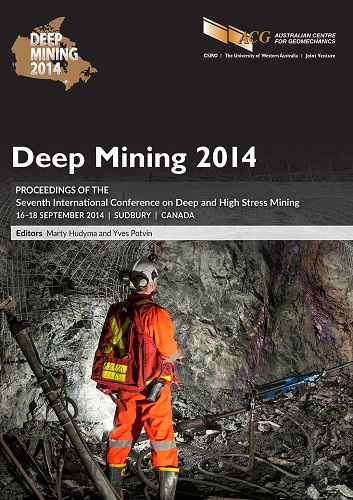Conciliating ventilation requirements and geomechanical requirements for deep mining

|
Authors: Thibodeau, D; Jodouin, J |
DOI https://doi.org/10.36487/ACG_rep/1410_56_Thibodeau
Cite As:
Thibodeau, D & Jodouin, J 2014, 'Conciliating ventilation requirements and geomechanical requirements for deep mining', in M Hudyma & Y Potvin (eds), Deep Mining 2014: Proceedings of the Seventh International Conference on Deep and High Stress Mining, Australian Centre for Geomechanics, Perth, pp. 783-791, https://doi.org/10.36487/ACG_rep/1410_56_Thibodeau
Abstract:
As mines go deeper, managing heat due to the geothermal gradient, auto compression and the large diesel equipment used to achieve production is a constant battle. Ventilation requirement to cool down the work place is in constant opposition to the geomechanical constraints related to increased stress level, seismicity and rock mass failure. To minimise the energy used to push air through the deep workplaces of a mine, ventilation requires large conduits to keep friction and turbulence to a minimum and avoid undue warming of the fresh air before it reaches its destination. On the contrary, smaller openings at depth allows mines better mitigation of geomechanical risk providing improved long term stability and allowing permanent infrastructures to be closer to the ore body. Ventilation and geomechanical considerations, being the two pillars of deep mine design, are opposed to each other. This paper demonstrates how ventilation requirements and geomechanical requirements can be conciliated for deep mine design to ensure safe production. This paper describes the basic ventilation requirement for deep mining using a hypothetical case stipulating optimum design criteria for the underground openings. Based on the ventilation requirement, a list of compromises or mitigation measures will be reviewed to improve mine design both from ventilation and a geomechanical point of view. Furthermore, a list of technical and financial impact of the ventilation and geomechanical conciliated design will also be provided.
References:
*m and S are Hoek and Brown constant for a brittle failure criterion (Hoek & Brown 1980, 1988; Martin et al. 1999).
In order to ensure good practice in the ventilation design phase of a study, design principles must be established. Best practice mine ventilation system design is based on the following criteria:
Acuña, E & Jodouin, J (2010), ‘Optimisation of Upper Kelly Lake Project Ventilation Design’, Proceedings of the CIM MEMO Conference and Exhibition, Canadian Institute of Mining, Metallurgy and Petroleum, Westmount.
Acuña, E, Hall, S & Lowndes, IS 2010, ‘Free and semi controlled splitting network optimization using GAs to justify the use of regulators’, in R Castro, X Emery & R Kuyvenhoven (eds), Proceedings of the 4th International Conference on Mining innovation: MININ 2010, Gecamin, Santiago, pp. 79-87.
Barton, NR, Lien, R & Lunde, J 1974, ‘Engineering classification of rock masses for the design of tunnel support’, Rock Mechanics, vol. 6, no. 4, pp. 189-239.
Calizaya, F, McPherson, MJ & Mousset-Jones, P 1987, ‘An algorithm for selecting the optimum combination of main and booster fans in underground mines’, Proceedings of the 3rd US Mine Ventilation Symposium, Society for Mining, Metallurgy, and Exploration, Englewood, pp. 408-417.
Hartman, HL, Mutmansky, JM, Ramani, RV & Wang, YJ 1997, ‘Economics of Airflow’, Mine ventilation and air conditioning, John Wiley & Sons, New York, pp. 431-451.
Hoek, E & Brown, ET 1980, ‘Empirical Strength Criterion for Rock Masses’, Journal of Geotechnical Engineering Division, vol. 106(GT9), pp. 1013-1035.
Hoek, E & Brown, ET 1988, ‘The Hoek-Brown Failure Criterion - a 1988 Update’, in JC Curran (ed.), Proceedings of the 15th Canadian Rock Mechanics Symposium, University of Toronto, pp. 31-38.
Huang, C & Wang, YJ 1993, ‘Mine ventilation network optimization using the generalized reduced gradient method’, in R Bhaskar, Proceedings of the 6th US Mine Ventilation Symposium, Society for Mining, Metallurgy, and Exploration, Englewood, pp. 153-161.
Le Roux, WL 1972, ‘Present values’, Mine Ventilation Notes for Beginners, The Mine Ventilation Society of South Africa, Marshalltown, pp. 189-192.
Lowndes, IS, Fogarty, T & Yang, ZY 2005, ‘The application of genetic algorithms to optimize the performance of a mine ventilation network: the influence of coding method and population size’, Soft Computing, vol. 9, pp. 493-506.
Martin, CD, Kaiser, PK & McCreath, DR 1999, ‘Hoek–Brown parameters for predicting the depth of brittle failure around tunnels’, Canadian Geotechnical Journal, vol. 36, no. 1, pp. 136-151.
McPherson, MJ 1993, ‘Ventilation Planning’, Subsurface Ventilation and Environmental Engineering, Chapman & Hall, London, pp. 263-290.
Volz, MG, Brazil, M & Thomas, DA 2009, ’Strategic optimisation of a vertical hoisting shaft in the Callie underground mine’, Proceedings of the Orebody Modelling and Strategic Mine Planning Symposium, in R Dimitrakopoulos (ed.), The Australasian Institute of Mining and Metallurgy, Carlton South, pp. 243-248.
© Copyright 2024, Australian Centre for Geomechanics (ACG), The University of Western Australia. All rights reserved.
View copyright/legal information
Please direct any queries or error reports to repository-acg@uwa.edu.au
View copyright/legal information
Please direct any queries or error reports to repository-acg@uwa.edu.au